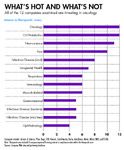The Shakeout
Pharmaceutical Executive
When it comes to licensing in this market, there are winners and losers. Learn the new rules of the game.
What pharma wants, biotech has. So how can it be that large pharmaceutical and biotech companies face an unprecedented need for products at the same time that emerging companies with promising drugs face—in large part—bankruptcy?

DEAL TRENDS REFLECT THE NEEDS IN THE PIPELINE
Of course, deals will continue to occur, but a shakeout is coming to the pharma and biotech industry. Surviving in an environment like this starts with understanding the current situation, which presents industry leaders with a challenge because strong forces are pulling in opposite directions. The three sets of conflicting pressures are:
1. The exclusivity cliff vs. the Phase II "baby boom"
2. Financial distress of emerging companies vs. reduced appetite for risk of larger companies
3. Competition for products in select fields vs. an oversupply of development programs in de-prioritized areas
This article explores these conflicting pressures and discusses the five actions that smart out-licensing companies should take to thrive in this bifurcated market. On one side are factors that suggest licensing activity could "catch fire" in 2009; on the other, factors indicating that licensing activity could collapse. In the end, neither extreme is likely to be the case. Rather, we are likely to see a flurry of activity in selected areas and strong declines in others. Most importantly, success is only likely to come to the out-licensors who recognize the new perspective of in-licensors and adjust their licensing approach accordingly.
Massive Patent Expirations Vie with Surplus of Pipeline Products
Deal Upside: The Exclusivity Cliff
Everyone in the industry knows the dreaded date—2011. That's the year that billions of dollars will go off patent, putting an 11-year high water mark for revenue at risk. Most of the leading companies will be affected, with products losing patent protection to include Pfizer's Lipitor, Bristol-Myers Squibb's Plavix (in the US), GlaxoSmithKline's Advair, AstraZeneca's Seroquel, Takeda's Actos, and Lilly's Zyprexa.

TIGHT CASH FOR US BIOTECHS
Certainly, the industry has spent years planning ahead for the patent cliff. Logically, these major patent expirations should fuel pharmaceutical and biotech companies' interest in licensing. That need for near-term revenue was reflected in 2008 licensing trends; deals with large up-front payments (above $10 million) for Phase III deals increased in the second half of 2008, as deals for Phase II products declined sharply. With all this activity, there aren't many more late-stage products with high sales potential still available for licensing—but it's certain there will be a bidding war for the attractive ones that remain. (See "Deal Trends Reflect the Needs in the Pipeline".)
Deal Downside: The Phase II Baby Boom
If there's a bright spot in the industry's pipelines, it's in Phase II. (See "Burgeoning Phase II Pipelines"). Over the past five years, the pharmaceutical and biotech industry has made vast investments in early-stage technologies and committed unprecedented resources to develop products aimed at new targets and pathways. Millions of dollars later, the industry is fat with Phase II compounds in development. However, it will be some time before these compounds overcome the steep clinical and regulatory hurdles they face. However, if this generation of Phase II products—which we call the Phase II Baby Boom—is at least as effective as its predecessors, success rates will overwhelm companies' budgets for Phase III trials.
Fortunately, a range of alternatives is emerging for dealing with the Phase II Baby Boom. To make better choices about which compounds to move forward, companies are applying "rapid review" development processes to cost-effectively learn more about their Phase II assets. In parallel, advances in biomarkers are allowing some companies to peek inside the body's biochemical processes and test whether drugs are having the desired effect.

WHAT IS HOT AND WHAT IS NOT
Leading companies are also applying models to reduce the risk for Phase III investments. Lilly, for example, has found financing partners to take on part of the cost of risky Phase III programs. (Those partners, of course, expect to share in the returns for the product.) BMS took another non-traditional approach by sharing development risk for high-cost Phase III programs with other large companies, including deals with Pfizer on apixaban, with Merck on muraglitazar, and with AstraZeneca on saxagliptin.
In the near term, the new approaches to Phase II programs may increase attrition rates, resulting in fewer programs moving into Phase III. Large pharmaceutical and biotech companies may be less likely to look outside their own pipelines unless there is a very compelling case for displacing an existing pipeline product. This may also mean that lower priority, but still viable, Phase II programs get cut from pharma portfolios because limited development budgets are reserved for the higher priority programs.

BURGEONING PHASE II PIPELINES
Cheap Assets Abound as Companies Tighten Belts
Deal Upside: Financial Distress of Emerging Companies
The current financing environment is taking a toll on both emerging biotech companies. According to a late 2008 report from the Biotechnology Industry Organization, 46 percent of 387 publicly held US biotech companies surveyed have less than two years' worth of cash on their books. An astonishing 34 percent have less than a year of cash left. At the same time, funding is down significantly for private companies, and the opportunity for an IPO is virtually non-existent. (See "Tight Cash for US Biotechs".)
Most emerging companies have responded by cutting costs by focusing on lead programs and minimizing staff. In a recent review, Campbell Alliance identified more than 80 emerging companies that announced major staff reductions in 2007 and 2008. In 2009, the trend may continue, with companies reducing staff to align with a focused set of development programs.?Future reductions could occur as those programs experience normal levels of attrition.
Financial distress creates opportunities for deal-making and M&A. Companies are not going to buy unattractive programs because they're cheap, but many companies are seeing a risk/reward trade-off that they can't resist. While the flurry has yet to occur, some mid-sized and larger companies are beginning to actively track companies with promising late-stage programs but limited cash.
Deal Downside: Reduced Appetite for Risk
The volatility in the worldwide economic environment is creating less tolerance for risk. All companies, regardless of size, are reducing costs and preserving capital. This "belt-tightening" is making companies more inwardly focused and less inclined toward outside deals. An initial sign of this might be seen in the reduction in Phase II deals.
In the early 2000s, some large pharmaceutical and biotech companies would overlook or discount the level of risk surrounding a potential asset in favor of filling their product pipelines. But in recent years, the tolerance for risk has dropped as pipelines were slowly replenished through a combination of in-licensing, acquisitions, and internal development efforts (as evidence by the Phase II Baby Boom). Even though companies are still competing to get the "right" deals done for the most attractive assets available, they are wary of taking on development or financial burdens that may not bear appropriate returns. Moreover, development organizations face the same belt-tightening applied to commercial organizations. Today's investment dollars are dear, and they're not likely to be applied to riskier programs even if the rewards suggest the outlay is justified.
En Vogue Therapeutic Areas Offer an Upshot Versus Differentiated Drugs
Deal Upside: Competitive Nature of Select Therapeutic Areas
For those who attend the usual business development and partnering conferences around the globe, the most up-to-date information on a given company's therapeutic areas of interest is found in companies' business development brochures. We recently consolidated information provided by leading companies on the areas where they are focusing their licensing efforts.
Of the top 12 traditionally small molecule–focused pharmaceutical companies, all 12 have expressed an interest in oncology and metabolic disease. Eleven of the 12 are looking for neuroscience (CNS) products, and nine of 12 are specifically looking for pain products. On the other hand, only six companies report focusing on respiratory products, five companies are looking for opportunities in gastroenterology (GI), and only four are interested in ophthalmology products. With large companies essentially all looking for the same types of products, out-licensors with high-quality assets in desirable therapeutic areas will likely have many suitors.
Deal Downside: Movement Away From Previous Therapeutic Areas
While many companies are moving toward oncology and CNS, industry headlines report movement away from certain other therapeutic areas. We've seen that before. In the early 2000s, many companies moved away from respiratory and women's health conditions. In September 2008, Pfizer surprised many when the company announced that it was cutting early-stage funding of cardiovascular programs. Similarly, AstraZeneca signaled its de-prioritization of investment in GI when the company spun out several development programs to Albireo in February of 2008.
In the long term, a select group of companies are likely to succeed by bucking the trends. Look for mid-sized companies focused on GI or women's health to break out of the pack, as Shire (CNS and GI) or Gilead (infectious disease) did during the early 2000s. However, in the near term, it means that there are fewer targets for emerging companies developing assets in these areas. Finding financing or attractive deal terms may be more difficult for these companies, even if they hold the assets that prove in the end to have been the most attractive. These companies may have to look harder at options to commercialize their own assets—which may lead to mergers within this group of companies in order to boost economies of scale.
Survival Means...
As a result of the conflicting market pressures, the industry is headed for a shakeout. Companies with products with strong profiles in desirable therapeutic areas will see increased interest and licensing activity, and will be positioned to succeed. Companies that may have products in less-desirable therapeutic areas with less favorable profiles—or an inability to concisely tell the value "story" around their product—will face troubled times, and quite possibly failure. In the past, a larger share of these companies might have struggled on; some would have seen their products through the exhilarating experience of later-stage development. Not this year. Only the companies that navigate carefully through this environment will see their products advance.
In order to survive the shakeout, smart out-licensing companies should do five things.
1. Evaluate your offering It is essential to evaluate the strengths and weaknesses of your portfolio in light of the factors driving market bifurcation. Know where you stand, so you can fully understand your position in this changing marketplace. The sooner this is done, the more time companies will have to take appropriate action.
2. Tell your story well It is critical that out-licensors have a well-thought-out approach to communicating the value "story" of their pipeline and individual assets. While products with poor clinical data are likely to fail regardless of how they're positioned, proven products are not necessarily guaranteed success. Be certain to put your offering in context within the market and the partner's specific interests, and make an airtight case for the quality and value of your assets.
3. Leverage the advantage of multiple suitors Companies should ensure that they undertake a process to reach out to all parties who may be interested in an offering. Approach your deal with an auction mentality, promoting a competitive environment among potential partners bidding to do business with you. In a market environment where potential in-licensors are looking closely at the same therapeutic areas and products, you should keep in mind that your valuation is partially driven by the fear that another company will scoop up your product.
4. Partner early Out-licensors need to partner early to ensure that they are negotiating with potential partners from a position of strength. By no means should you be in financial distress while trying to negotiate; this will only attract "sharks" determined to take advantage of the situation. Partnering early also ensures that you are not left holding the bag if the market turns or if negative data is uncovered. Creative deal-structuring can work to preserve your share of future value, while at the same time managing risk for both you and your partner. Of course, there's a risk/benefit trade-off, and some companies may choose to wait for a potentially larger deal once an asset is in later stages. But more often than not, companies cannot afford the trials in the interim.
5. Understand your potential partner's needs Out-licensors must understand and clearly communicate where their product fits in a potential partner's pipeline. Knowing target companies inside-out, as well as the value your product can bring to their business, will raise your profile and position you for a deal. For example, if the company you've targeted has an asthma product coming off patent in the next few years, and you have a Phase III asthma product that is likely to be approved in the near term, then it's important to clearly communicate the notion that you can fill a key pipeline gap for your potential partner.
The shakeout will bring with it headline deals and headline disasters. Large pharma and biotech companies are likely to pay top dollar for products—or even companies—with a high probability of success. And it's also probable that we'll see bidding wars for the highest value assets in the most sought-after therapeutic areas—namely oncology and CNS.
For those emerging companies that fail to recognize the prevailing trends, the end result could mean a last-minute "fire sale" of assets in an effort to get cash on hand simply to survive or, even worse, bankruptcy. Licensors need to be both nimble and savvy to ensure that they're on the right side of the shakeout and come out unscathed.
Ben Bonifant and Joe Dillon are executives in the Business Development Practice at Campbell Alliance, a pharmaceutical and biotech management consulting firm. They can be reached at bbonifant@campbellalliance.com and jdillon@campbellalliance.com.
The Misinformation Maze: Navigating Public Health in the Digital Age
March 11th 2025Jennifer Butler, chief commercial officer of Pleio, discusses misinformation's threat to public health, where patients are turning for trustworthy health information, the industry's pivot to peer-to-patient strategies to educate patients, and more.
Navigating Distrust: Pharma in the Age of Social Media
February 18th 2025Ian Baer, Founder and CEO of Sooth, discusses how the growing distrust in social media will impact industry marketing strategies and the relationships between pharmaceutical companies and the patients they aim to serve. He also explains dark social, how to combat misinformation, closing the trust gap, and more.
